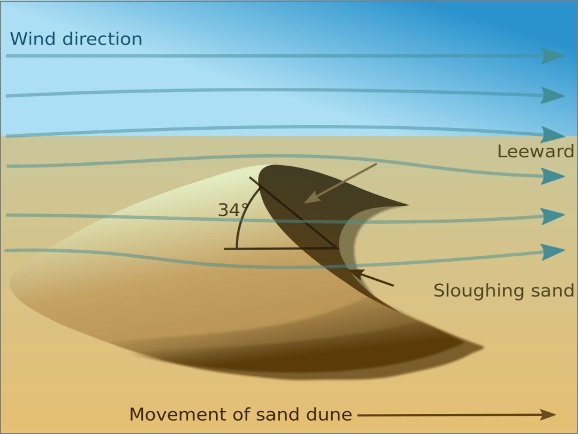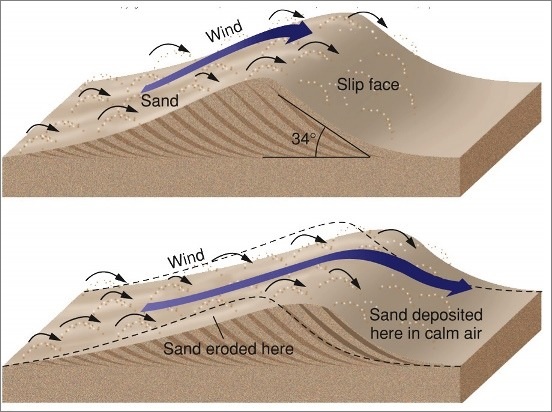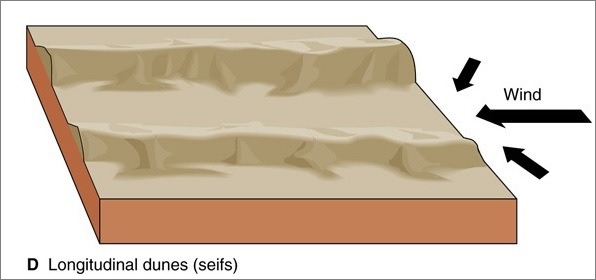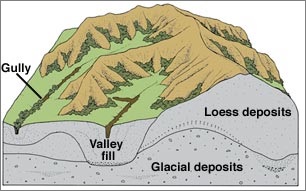Landforms of Wind Deposition in Deserts
by Devender
0 1501
The materials eroded by winds get transported with it but they come to rest somewhere. The finest dust travels great distances in the air before settling down and sometimes even to 2300 miles.
Landforms of Wind Deposition in Deserts
Sometimes, the dust from the Sahara desert gets blown across the Mediterranean to fall as blood rains in Italy or on the glaciers of Switzerland. The dust that settles in the Hwang Ho basin (also known as Hwangtu – the yellow earth) from the Gobi desert has been accumulated over past centuries to a depth of several hundred feet.
- The wind-borne materials are shifted according to their coarseness
- The coarser sands are too heavy to be blown out of the desert limits
- They remain as dunes or other depositional landforms within the desert themselves
- Dunes
- Barchan
- Seifs
- They occur transversely to the wind, so their horns thin out & become lower in the direction of the wind
- Mainly due to reduced frictional retardation of the winds around the edges
- The windward side is convex & gently sloping
- The leeward side, being sheltered, is concave & steep
- Loess
- It is a yellow and friable (softly crumbled) material rich in lime
- It is very coherent, extremely porous & is usually very fertile
Dunes are the hills of sand formed by the accumulation of sand & shaped by the movement of winds. It is a striking characteristic of erg or sandy desert. Dunes can be classified as active or live dunes, constantly on the move, or inactive fixed dunes, rooted with vegetation.
The two of the most common types of dunes are:
1 Barchan dune
These are crescent or moon-shaped live dunes which advance steadily in the particular direction of prevailing winds. These are initiated probably by a chance accumulation of sand across an obstacle, such as a patch of grass or a heap of rocks.

The crest of sand dunes moves forward as more sand is accumulated by the prevailing wind and with more sand driven up the windward side, it reaches the crest and slips down the leeward side so that the dune advances.

The migration of Barchans may be a threat to desert life as they may encroach on an oasis burying palm trees & houses. To prevent the advancement of the dunes to long-rooted sand holding trees & grasses are planted which also helps in preventing areas of fertile land from being devastated.
2 Seif or longitudinal dunes
These are long narrow ridges of sand, often over a hundred miles long, lying parallel to the direction of the prevailing winds. Their crustline rises & falls in alternate peaks & saddles in regular successions.
They are swept clear of sand & remain smooth as the dominant wind blows straight along the corridor between the lines of the dunes. The eddies that are set up in corridors, blow towards the side of the corridor & drops the sand to form the dune.

The prevailing winds increase the length of the dunes into tapering linear ridges while occasional crosswinds tend to increase their heights & width.
Loess is the fine dust blown beyond the desert limits and gets deposited on the neighboring lands.

The water sinks in readily so the surface is always dry. The streams cut into a thick mantle of soft loess to develop badland topography.

Share:







Comments
Waiting for your comments